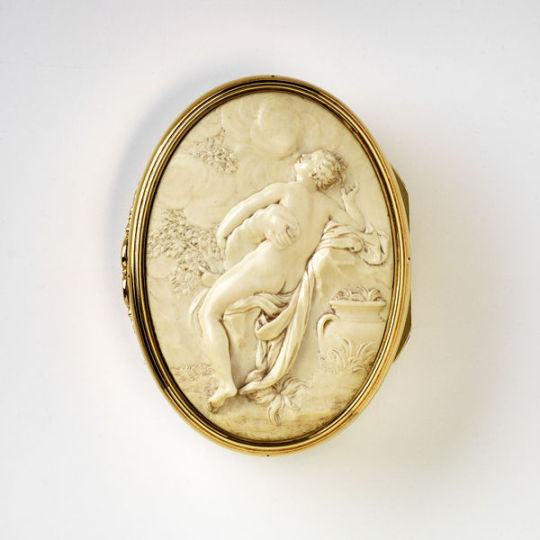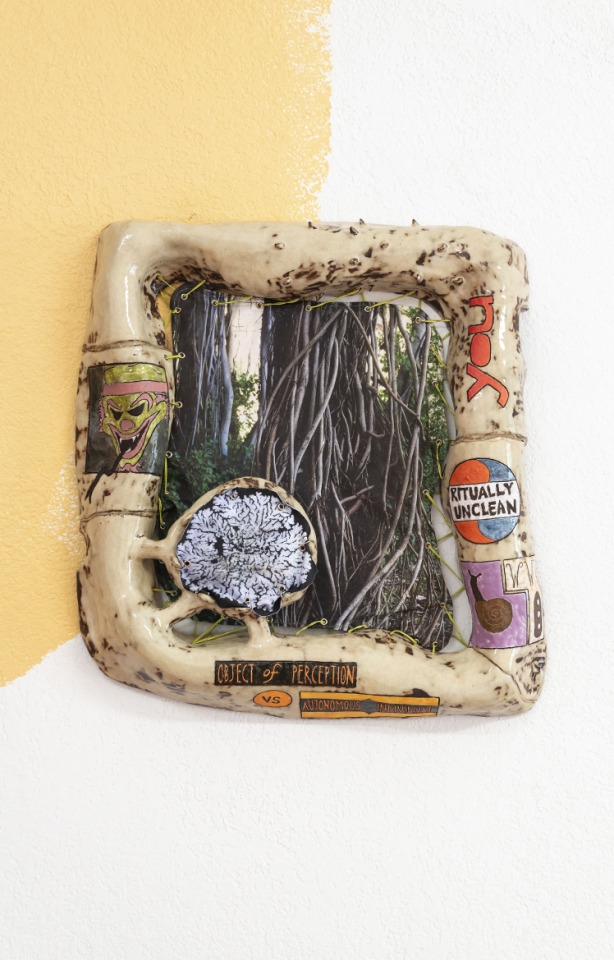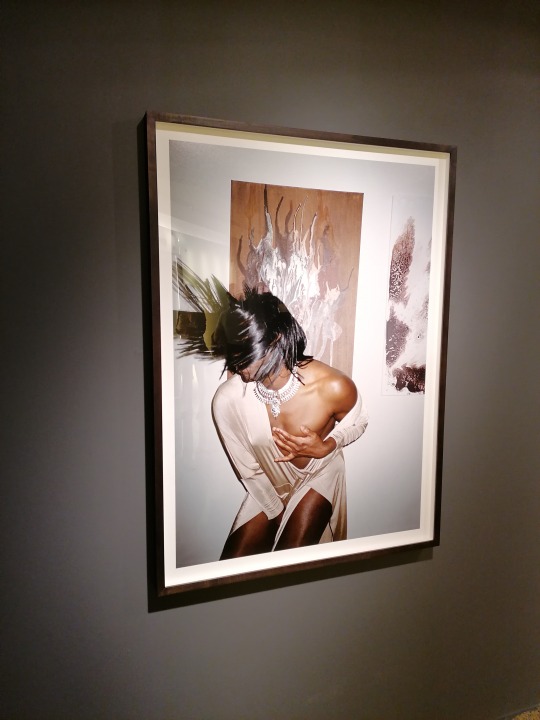Text
Before the French revolution, the most sought-after architects, designers and craftsmen in Paris had workshops for the production of little boxes and trinkets. At the height of the craze for courtly elegance, these ‘toys’ could be found all over Europe and Russia, in pockets newly sewn into trousers and skirts. King Frederick of Prussia, a huge collector of little boxes, carried one around with him at all times. It was even said that his snuffbox stopped a bullet from killing him during the Seven Years War. Later, before he died, he had them all laid out in his room, surrounding him like reliquaries, or miniature tombs.
1 note
·
View note
Text

Ivory snuffbox showing the Abduction of Io, 1825. V&A Museum, London.
Over the last few weeks, during my lockdown drift, I’ve been browsing through a collection of pocket snuffboxes held at the Victoria and Albert Museum in London. Snuffboxes were lavishly decorated containers used to store pulverized tobacco, a popular stimulant and panacea for the aches and pains of the European aristocracy during the colonial period. The boxes at the V&A – available to view in intricate detail online – are glitzy, ostentatious combinations of gold, silver, tortoise shell, fine wood, diamonds, and semi-precious stones. Many include tiny porcelain paintings of lovers or tales from antiquity. This one, made in London in 1825, features an elaborately carved ivory depicting the rape of Io, a priestess of the goddess Hera, seduced by Zeus in the form of a cloud. Another box from Germany in 1765, made of a lawn-green chrysoprase and diamonds laid over pink, orange, and yellow tinsel, slightly resembles a rose garden, or a really gaudy Claire’s compact.
Before the French revolution, the most sought-after architects, designers and craftsmen in Paris had workshops for the production of little boxes and trinkets. At the height of the craze for courtly elegance, these ‘toys’ could be found all over Europe and Russia, in pockets newly sewn into trousers and skirts. King Frederick of Prussia, a huge collector of little boxes, carried one around with him at all times. It was even said that his snuffbox stopped a bullet from killing him during the Seven Years War. Later, before he died, he had them all laid out in his room, surrounding him like reliquaries, or miniature tombs.
I don’t know what got me thinking about this object, but now it won’t leave me alone. It keeps coming into my mind, troubling me during moments I least expect it. Maybe it has something to do with the word. ‘Snuffbox’ conjures up all sorts of unsettling associations. ‘Snuff out,’ ‘snuff film,’ putting something in a box, a casket. In addition to keeping someone’s hands busy, offering snuff evolved into a secret social code of wordless gestures, the ‘Language of the Tabatière.’ I can’t help but imagine that these boxes were somehow a precursor to the iPhone, their role as addictive distraction well outliving the form.

Chrysoprase & diamond snuffbox owned by Frederick II, 1765. V&A Museum.
Although hugely popular in Europe, snuff was originally used by indigenous populations across Brazil and the West Indies. While traveling the New World as part of Columbus’ second voyage, a Franciscan monk came upon a priest in Haiti snorting pulverized tobacco. The still mysterious herb was then introduced to the Spanish court and promoted as a cure for headaches. Under the reign of Queen Anne, snuff was called the “final reason for the human nose,” while Catherine de Medici proclaimed it the “Herba Regina.” By the 17th century, England, Portugal, and Spain all had colonies in the Americas in order to satisfy a growing demand in Europe. Having exhausted the labor of native populations, roughly 10.5 million Africans were transported to work on tobacco, rice, and sugar plantations in South America and the Caribbean. (For comparison, only about 6% of people enslaved as part of the Trans-Atlantic Slave Trade were shipped to North America). In retrospect, the winsome décor of the snuffbox seems to contradict, obscure, or deny this wider history of cultural robbery and enslavement.
“Jack and the Golden Snuffbox” is an English fairy tale recorded by folklorist Joseph Jacobs in an 1890 anthology of English children's stories. In the story, Jack, a young boy, decides to leave his provincial home in order to explore the world and discover a new life for himself. To help him along his journey, his father gives him a magical snuffbox. After wandering for some time, Jack is taken in by a maid and her father. Jack falls in love with the maid, but her father won’t let him marry unless the boy satisfies an impossible demand. “At eight o’clock in the morning,” he says, “I must have a great lake and some of the largest man-of-war vessels sailing before my mansions, and one of the largest vessels must fire a royal salute, and the last round must break the leg of the bed before where my young daughter is sleeping. And if you don’t do that, you will have to forfeit your life.” Without any recourse, Jack decides to open up the golden snuffbox. Out come three little red men, who build him a large, supernaturally endowed war vessel floating on a lake.

Rococo engraving by Jean Mondon, 1740.
I’m no authority on folklore, and this is just the beginning of the tale. But the imagery is striking. It isn’t surprising that the snuffbox would be considered an enchanted object. The powder, originating from the Haitian ritual, was thought to have mysterious healing properties. The box could also be considered a protection from death, as the legend of King Frederick shows. But what about the psychological drama behind Jack and his future father-in-law? I’m reminded of a passage from Toni Morrison’s Playing in the Dark: Whiteness and the Literary Imagination, in which she investigates the allure of the New World as an opening for Englishmen looking to escape the “powerlessness felt before the gates of class, caste, and cunning persecution.” One could move from “discipline and punishment to disciplining and punishing; from social ostracism to social rank.” We are told that the pressures Jack faces are inordinately difficult, blown out of realistic proportion. Essentially a penniless boy, he builds himself a war vessel, clears a piece of land, travels the world, but only through the help of the red men, imagined to be otherworldly, mute, exploitable.
When I started investigating the snuffbox, an object I came across more or less at random, I did not expect to discover such a layered history. It’s colonial background, magical suggestion, and excessive decoration are rooted in a historical time and place, but it isn’t disconnected from the here and now. “Sometimes first impressions gather up some of the residue of centuries,” says John Berger. Maybe it isn’t so strange I would have thought about this object when white Europe and America are again realizing how far off the mark they are in attempting to right the wrongs of the colonial past. This highly crafted, dazzling, revealing little object makes me consider the difference between a beauty that seeks to conceal or compensate for brutality, versus the kind of beauty in art that challenges violence, rejects it, and ultimately enables us to see more clearly our own tendencies for both violence and compassion. These are questions I am thinking about in the wake of George Floyd’s murder, when the virality surrounding his death – as well as Breonna Taylor, Ahmaud Arbery, Elijah McClain – has been such a prominent part of current visual culture.
Death has never had a mimetic afterlife quite like this. It is there in our hand-held devices, flattened to fit into a stream of other images. Names of people who have lost lives to police brutality have occasionally been aestheticized with the help of colorful graphics for wider sharing. Are there conflicting desires behind these pictures – to both reveal and obscure? Many writers have recently challenged us to think harder about sharing on social media, including Allissa V. Richardson in her new book, Bearing Witness While Black. In her brilliant film essay and lecture, “The Black Meme,” Legacy Russell points out that there has been a certain amount of ‘gamifying’ in attempts to fit Breonna Taylor’s name into clever tweets, grocery lists, and crossword puzzles. We do not yet have the ability to look back and see what the real-life outcome of widespread sharing on social media will be. But I wondered, when scrolling through the images of the boxes on the V&A’s website, whether it wasn’t possible for people to give more consideration to what it was they are holding in their hands, and the meanings behind their own rituals of sharing. Do trends on social media somehow anesthetize us to the pain of the story? Are they themselves a form of distraction? Could I be involved in more pro-active forms of justice, and working on a more transformative form of art? The past filters into the present in ways we least expect it. It is there to help, if only we can tune in and listen.
2 notes
·
View notes
Text

Here's an object I've never seen before, by the artist Manal Kara. I love this thing. It reminds me of a clock, or the way a clock looked to me when I was a kid and too young to read the numbers or hands. I liked all the clocks in Disney's Pinocchio. In fact I'd play that scene on repeat, just Geppetto winding up his creations with all their distinct dancing parts, and the whole unfolding ceremony when the clocks struck the hour. Time means something different if at 8am a miniature bird pops out of a door and at 3pm a bucket of fake water spills over a garden carved out of wood. Now that I'm thinking about it, Kara's objects have nothing at all to do with clocks.
I’m not sure what people mean when they use the term 'slow object' but I'm thinking this is one. You can see how it's made and imagine how long it took. The ceramic frame was molded, punctured with holes, glazed to look like wood. The artist has carefully tattooed designs into the flesh of the clay. I want to try and read them in a circle, like, "You, a ritually unclean snail on the web, an object of perception, vs an autonomous individual, a cerebral demon with a snake’s tongue.” The ‘face’ of the clock is an image of a strangler fig, a kind of vine-tree that winds around a host plant and becomes one with it. Are we a ‘host’ for Time? Mother Earth? I don’t know. We're in the deeper regions here, where numbers aren't numbers but symbols, and symbols are personal and charged with meaning.

0 notes

